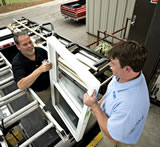New Windows in Raleigh
Looking for New Windows in Raleigh? There are many decisions to be made in choosing replacement windows, including which manufacturer, which type of window and which features you need. The guys at "My Guys Remodeling" can guide you through all the decisions and help you make the right choice for your home and budget.
Raleigh City Statistics
Raleigh is the capital of the state of North Carolina and the seat of Wake County. Raleigh is known as the “City of Oaks” for its many oak trees. It is the second most populous city in North Carolina after Charlotte.[3] The estimated population on January 1, 2009 was 385,507. According to the U.S. Census Bureau, it is the fastest growing metropolitan area in the nation.
Raleigh, Durham, and Chapel Hill make up the three historically primary cities of the Research Triangle metropolitan region. The regional nickname of "The Triangle" originated after the 1959 creation of the Research Triangle Park, located between the cities of Raleigh and Durham. The Research Triangle region encompasses the U.S. Census Bureau's Combined Statistical Area (CSA) of Raleigh-Durham-Cary in the central Piedmont region of North Carolina. The estimated population of the Raleigh-Durham-Cary CSA was 1,635,974 as of July 1, 2007, with the Raleigh-Cary Metropolitan Statistical Area (MSA) portion estimated at 1,047,629 residents.
Most of Raleigh is located within Wake County, with a very small portion extending into Durham County. The towns of Cary, Garner, Wake Forest, Apex, Holly Springs, Fuquay-Varina, Knightdale, Wendell, and Rolesville are some of Raleigh's primary nearby suburbs and satellite towns.
18th century
In December 1770, Joel Lane successfully petitioned the North Carolina General Assembly to create a new county, resulting in the formation of Wake County. The county was formed from portions of Cumberland, Orange, and Johnston counties. the county gets its name from Margaret Wake Tryon, the wife of Governor William Tryon. The first county seat was Bloomsbury.
Raleigh was chosen as the site of a new state capital in 1788. It was officially established in 1792 as both the new county seat and the new state capital. The city was named in 1792 for Sir Walter Raleigh, sponsor of the Colony of Roanoke. The "Lost Colony" is commemorated at the Fort Raleigh National Historic Site on Roanoke Island, North Carolina.
The city's location was chosen, in part, for being within 10 miles (16 km) of Isaac Hunter's Tavern, a popular tavern frequented by the state legislators. No known city or town existed previously on the chosen city site. Raleigh is one of the few cities in the United States that was planned and built specifically to serve as a state capital. Its original boundaries were formed by the downtown streets of North, East, West and South streets. It was planned to be laid out in an axial fashion, with four public squares and one central square.
The North Carolina General Assembly first met in Raleigh in December 1794, and quickly granted the city a charter, with a board of seven appointed commissioners (elected by the city after 1803) and an "Intendant of Police" (which would eventually become the office of Mayor) to govern it. In 1799, the N.C. Minerva and Raleigh Advertiser became the first newspaper published in Raleigh. John Haywood was the first Intendant of Police. Raleigh's Historic Oakwood contains many houses from the 1800s that are still in good condition.
19th century
Raleigh, North Carolina in 1872
In 1808 Andrew Johnson, the nation’s seventeenth President, was born at Casso’s Inn in Raleigh. The city's first water supply network was completed in 1818, although due to system failures the project was abandoned. 1819 saw the arrival of Raleigh's first volunteer fire company, followed in 1821 by a full-time fire company.
In 1831, a fire destroyed the State Capitol. Reconstruction began two years later with quarried granite being delivered by the first railroad in the state. Raleigh celebrated the completions of the new Capitol and new Raleigh & Gaston Railroad Company in 1840.
In 1853, the first State Fair was held near Raleigh.
The first institution of higher learning in Raleigh, Peace College, was established in 1857.
After the War began, Governor Zebulon Baird Vance ordered the construction of breastworks around the city as protection from Union troops. During General Sherman's Carolinas Campaign, Raleigh was captured by Union cavalry under the command of General Hugh Judson Kilpatrick on April 13, 1865. After the Confederate cavalry retreated west , the Union soldiers followed, leading to the nearby Battle of Morrisville. The city was spared significant destruction during the War, but due to the economic problems of the post-war period and Reconstruction, it grew little over the next several decades.
North Carolina State Capitol, c 1861. Governor David S. Reid is in the foreground
North Carolina State Treasurers Office in State Capitol, c 1890s
After the Civil War ended in 1865, African Americans were able to be educated and men could become involved in politics. With the help of the Freedmen's Bureau, many freedmen migrated from rural areas to Raleigh. Shaw University, the South's first African-American college, began classes in 1865 and was chartered in 1875. Shaw's Estey Hall was the first building constructed for the higher education of black women, and Leonard Medical Center was the first four-year medical school in the country for African Americans.
In 1867, Episcopal clergy founded St. Augustine's College for the education of freedmen. In 1869, the state legislature approved the nation’s first school for blind and deaf African Americans to be located in Raleigh. And in 1874, the city's Federal Building was constructed in Raleigh, the first Federal Government project in the South following the Civil War.
In 1880, the newspapers News and Observer combined to form The News & Observer. It remains Raleigh's primary daily newspaper. The North Carolina College of Agriculture and Mechanic Arts, now known as North Carolina State University, was founded as a land-grant college in 1887. The city's Rex Hospital opened in 1889 and housed the state's first nursing school. The Baptist Women's College, now known as Meredith College, opened in 1891, and in 1898, The Academy of Music private music conservatory was established.
In 1900, the state legislature passed a new constitution, with voter registration rules that disenfranchised most blacks and many poor whites. Added to earlier statutory restrictions, the state succeeded in reducing black voting to zero by 1908. It was not until 1965 that the majority of blacks in North Carolina would again be able to vote, sit on juries and serve in local offices.
20th century
Intersection of Fayetteville and Martin Streets, c 1908
Fayetteville Street during the 1910s. The North Carolina State Capitol can be seen in the background
Construction of the Commercial National Bank building, c 1912
Martin Street business district, c 1915
In 1912, Bloomsbury Park opened, featuring a popular carousel ride. Relocated to Pullen Park, the carousel is still operating.
From 1914-1917, an influenza epidemic killed 288 Raleigh citizens. The state of North Carolina lost a total of 5,799 men in the World War I.
In 1922, WLAC signed on as the city's first radio station, but lasted only two years. WFBQ signed on in 1924 and became WPTF in 1927. It is now Raleigh's oldest continuous radio broadcaster.
The city's first airport, Curtiss-Wright Flying Field opened in 1929. That same year, the stock market crash resulted in six Raleigh banks closing.
During the difficult 1930s of the Great Depression, government at all levels was integral to creating jobs. The city provided recreational and educational programs, and hired people for public works projects. In 1932, Raleigh Memorial Auditorium was dedicated. The North Carolina Symphony, founded the same year, performed in its new home. From 1934-1937, the federal Civilian Conservation Corps constructed the area now know as William B. Umstead State Park. In 1939, the State General Assembly chartered the Raleigh-Durham Aeronautical Authority to build a larger airport between Raleigh and Durham, with the first flight occurring in 1943.
In 1947, Raleigh citizens adopted a council-manager form of government, the current form.
Raleigh experienced significant damage from Hurricane Hazel in 1954.
In 1956, WRAL-TV became the first local television station.
With the opening of the Research Triangle Park in 1957, Raleigh began to experience a population increase, resulting in a total city population of 100,000 by 1960.
Following passage of the federal Voting Rights Act, one of the main achievements of the African-American Civil Rights Movement (1955-1968) and the Lyndon B. Johnson presidency, political participation and voting by African Americans in Raleigh increased rapidly. In 1967, Clarence E. Lightner was elected to the City Council, and in 1973 became Raleigh's first African-American mayor.
In 1976, the Raleigh City and Wake County schools merged to become the Wake County Public School System, now the largest school system in the state and 19th largest in the country.
During the 1970s and 1980s, the I-440 beltline was constructed, easing traffic congestion and providing access to most major city roads.
The first Raleigh Convention Center (replaced in 2008) and Fayetteville Street Mall were both opened in 1977. Fayetteville Street was turned into a pedestrian-only street in an effort to help the then-ailing downtown area, but the plan was flawed and business declined for years to come. Fayetteville Street was reopened in 2007 as the main thoroughfare of Raleigh's downtown.
The 1988 Raleigh tornado outbreak of November 28, 1988 was the most destructive of the seven tornadoes reported in Northeastern North Carolina and southeastern Virginia between 1:00 AM and 5:45 AM. The Raleigh tornado produced over $77 million in damage, along with four fatalities (two in the city of Raleigh, and two in Nash County) and 154 injuries. The damage path from the storm was measured at 84 miles (135 km) long, and 0.5 miles wide at times.
In 1991, two large skyscrapers in Raleigh were completed, First Union Capital Center and Two Hanover Plaza, along with the popular Walnut Creek Amphitheatre in Southeast Raleigh.
In 1996, the Olympic Flame passed through Raleigh while on its way to the 1996 Summer Olympics in Atlanta, Georgia. Also in 1996, Hurricane Fran struck the area, causing massive flooding and extensive structural damage.
In 1999, the RBC Center arena opened to provide a venue for the National Hockey League's Carolina Hurricanes and NC State Wolfpack men's basketball teams.
21st century
In 2001, the Raleigh Memorial Auditorium complex was expanded with the addition of the Progress Energy Center for the Performing Arts, Meymandi Concert Hall, Fletcher Opera Theater, Kennedy Theatre, Betty Ray McCain Gallery and Lichtin Plaza.
Fayetteville Street reopened to vehicular traffic in 2006. A variety of downtown building projects began around this time including the 34-story RBC Bank Tower, multiple condominium projects and several new restaurants. Additional skyscrapers are in the proposal/planning phase.
With the opening of parts of I-540 from 2005-2007, a new 70-mile loop around Wake County, traffic congestion eased somewhat in the North Raleigh area. Completion of the entire loop is expected to take another 15 years.
In 2008, the city's Fayetteville Street Historic District joined the National Register of Historic Places.
Also in 2008, Raleigh has featured prominently in a number of "Top 10 Lists," including those by Forbes, MSNBC and Money Magazine, due to its quality of life and business climate.














